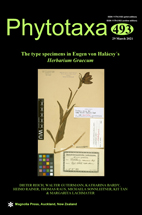Abstract
Greece, as one of the European biodiversity hotspots, is long since in the focus of botanical investigations. Among historical researchers significantly contributing to the floristic and taxonomic exploration was Eugen von Halácsy, a Viennese physician and botanist. He was the first and so far last author of a complete Greek flora, the Conspectus Florae Graecae, and has compiled a seminal herbarium collection of plant specimens originating from Greece. This Herbarium Graecum of approx. 26,000 vouchers, is today held by the Herbarium of the University of Vienna (WU). Investigations for original material in this collection yielded a total of 1,439 (approx. 5.5 %) vouchers. The current type status was checked for the entire material, the vouchers were databased, photographed and geo-referenced, and the data are made publicly available here. These results are presented in an annotated catalogue including 19 lectotypifications, in order to contribute to the still extremely active field of plant biodiversity research in Greece.

